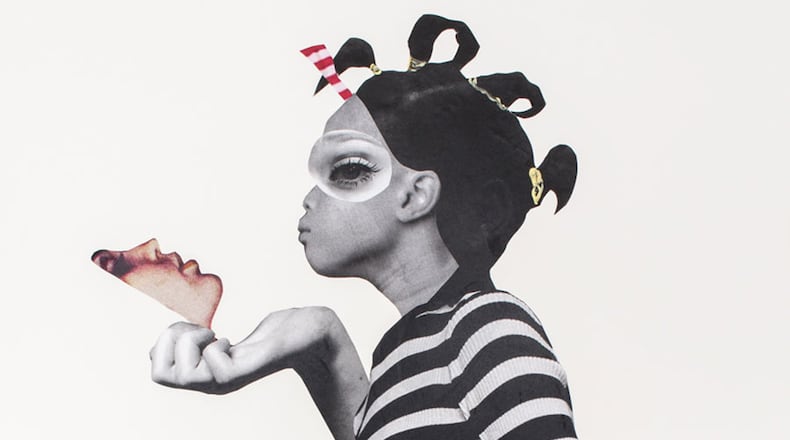Perhaps the ideal show for this #metoo moment, Deborah Roberts’ exhibition at the Spelman College Museum of Fine Art, “The Evolution of Mimi,” is at its heart a look at how black female identity is formed.
And for Roberts, how it is formed is in an atmosphere of scrutiny, judgment, condemnation and, finally, self-critique. To be female and black is to always look at oneself with a critical eye and measure oneself with the certainty that improvements must be made.
The Austin-based artist’s primary medium in this thought-provoking, rousing solo show is the collage. In her shape-shifting collisions of drawing and painting and found images, one thing is constant: Roberts’ focus on the icon of a little girl.
In Roberts’ hands, those girl-muses can represent many things. They are often powerhouses, fierce, raging forces to be reckoned with, with their enormous pasted-on, screaming mouths and cut-out eyes, enormous fists, knock knees and bobby socks. They stand with arms crossed, folded defiantly across their chests. The portraits are capable of projecting you back into the fun and fierceness of childhood, a time when your imagination was limitless. At times, Roberts’ images of these fierce little girls can suggest a fighting attitude. But, at other moments, they seem more about self-love and self-affirmation, stances grown women can lose sight of in a culture that can often poke holes in self-worth.
The idea of building her girls up from parts — lips clipped from here, hair from there — is a way of showing how these young girls struggle with the myriad expectations and desires of the world we live in, their identities fractured.
But “The Evolution of Mimi” gives a sense that, with age and experience, some of that attitude and sass Roberts discerns in her heroines diminishes, a fact that gives Roberts’ collages their bittersweet air.
Roberts’ show at Spelman shows a range of the artist’s work incorporating pieces from earlier in her career. Included are her more romantic portraits of young black girls that show Roberts’ efforts to privilege and valorize her subjects. Also featured in the exhibition are a series of text-centered serigraphs centered on “black” names and what they convey about race and class. Commentary is scrawled in the margins, offering judgments about the names being “way too black,” that suggest self-critique and the ways we limit and pigeon-hole each other. Next to those “black” names are a list of “white” ones — Bethany, Lindsey, Harlow, Paige — that illustrate how parents telegraph so much about themselves and their aspirations in a name.
In larger mixed-media works, Roberts can really amplify the pathos. Her “Lost Girls” image of a preteen girl in cat eye glasses and a skittish expression, both clothed and unclothed, hints at the vulnerability and the delicacy of childhood. Such works inspire a protective feeling, a sense of concern for this formative world of girls when so much innocence and optimism can be so easily, so cavalierly destroyed. That same girl is revisited in “Hoodratgurl,” her face erased in violet, scrawled gestures, as if her circumstance, her race, her neighborhood or her social standing have been used as an opportunity to dismiss, negate or ignore her.
“Deborah Roberts: The Evolution of Mimi”
Through May 19, 2018. 10 a.m.-4 p.m. Tuesdays-Fridays; noon-4 p.m. Saturdays. $3 suggested donation. Spelman College Museum of Fine Art, 440 Westview Drive, SW, Atlanta. 404-270-5607, www.museum.spelman.edu
Bottom line: Girlhood, in all its fierceness and insecurity, is the focus of this thought-provoking solo show.
About the Author
Keep Reading
The Latest
Featured


